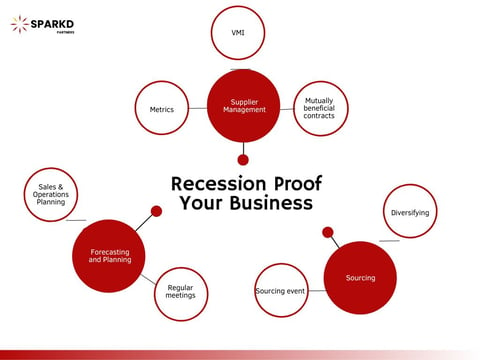Recession Proof Your Business (Part 1)
Recession-proofing a business requires taking proactive measures to ensure its long-term success and survival during economic downturns. The article document outlines some key strategies your business can implement.
BUSINESSTIPSRESILIENCESUPPLY CHAIN
The World Economic Forum's latest survey paints a gloomy picture of the global economy, with 20% of respondents now seeing an extremely likely chance of a global recession - double it’s survey in September 2022.
It highlights the growing need for companies to be prepared to navigate this economic climate with resilient supply chain processes and strategies. To assist in your preparations, we are providing a two-part guide on what to do in a recession. Part 2 will dive into the steps your company can take to mitigate the effects of a recession. Part 1 teaches you to implement proactive measures in your supply chain to prepare for and navigate a recession successfully.
Adopting these 3 tactics as part of an ongoing process will ensure the long-term resilience of your company's supply chain.
Forecasting and Planning
The first is forecasting and planning through Sales and Operations Planning (S&OP). This tactic is basic but crucial for the success of your company. In a recession, effective management of cash flow and inventory allows you to respond more effectively to meet the demands of customers and maintain the financial health of your business.
Sales and Operations Planning (S&OP) is a forecasting process that:
Ensures inventory is adjusted to meet the supply and demand data regularly
Predicts demand over various periods such as 3, 6, and 12 months to provide an overview of fluctuations over time.
A clear understanding of short- and long-term demands can help you plan buffer stock for right sized inventory and preserve a healthy cash flow.
Once the data has been analyzed, it should be shared between all stakeholders because sharing data keeps your organization on the same page and working towards a common goal. You can share data through regularly schedule meetings with both internal and external parties to help:
Share information and align expectations in order to prevent surprises and enable contingency planning
Prevent confusion, misunderstandings, and duplicated efforts
Review forecast, inventory and supply delivery data
Preparing for a recession is an ongoing process that requires building a foundation with the correct strategies.
Supplier Management
Strong relationships with key suppliers are crucial to establish before a recession hits. It ensures that your company has a reliable partner that can endure market challenges with you.
Mutually beneficial contracts:
Can help establish long-term partnerships and ensure a reliable supply chain even during times of economic uncertainty.
Ensure contracts with suppliers include clauses for significant market changes and outlines mechanisms to manage:
Supply Disruptions
Material Shortage
Higher-than-usual inflation
Even when contracts are already in place, establishing clear performance indicators helps you and your supplier manage expectations.
Metrics:
Cost and ease of business
Quality
Delivery (lead time)
Adherence to contracts (during quarterly review)
Additionally you can explore a supply chain management strategy known as Vendor Managed Inventory (VMI). In this system, the supplier takes responsibility for managing the inventory levels of your products.
VMI:
Lowers the inventory burden for a company
The supplier is responsible for managing inventory levels, rather than the customer. This helps improve a company's balance sheet by reducing the amount of inventory held, and lowers their working capital requirements.
Improve the efficiency of the supply chain by reducing the number of stockouts, and help to increase the accuracy of demand forecasts allowing for better utilization of resources and lower costs.
While VMI requires a great deal of trust between you and your supplier, the results are undeniable, corporations like Amazon and Walmart have used it successfully. With the correct partners, your company is better protected from disruptions resulting in a more resilient supply chain.
Sourcing
Analyze your business’ spend and identify products that are currently being purchased by only one supplier. This is considered a sole source risk. Diversifying your sources help your company:
Better manage risk.
Save money.
Access new ideas and technologies.
Become more resilient.
Conduct a sourcing event to qualify additional suppliers for your products. Here’s how:
Analyze and identify products that are currently being purchased from a single supplier.
Qualify additional suppliers (you can see how we qualify suppliers here)
Evaluate suppliers' financial risk and ability to manage market changes:
Consider their financial risk report and conduct a supplier audit.
Evaluate their ability to manage changes in the market,
Reduce reliance on custom materials
Where it doesn't significantly impact competitive advantage.
Implementing these strategies allows companies to lessen disruptions caused by lack of materials, plan for alternatives and choose suppliers for long-term benefit.
Conclusion
Taking proactive measures to recession-proof your business well in advance is crucial. By doing so, you can safeguard your supply chain and ensure that your business continues to operate smoothly in times of uncertainty.




